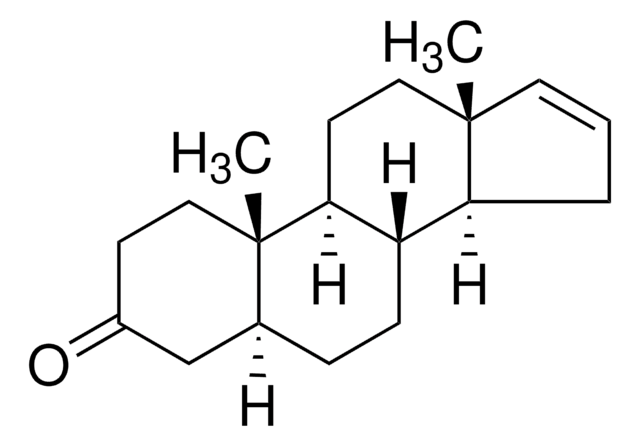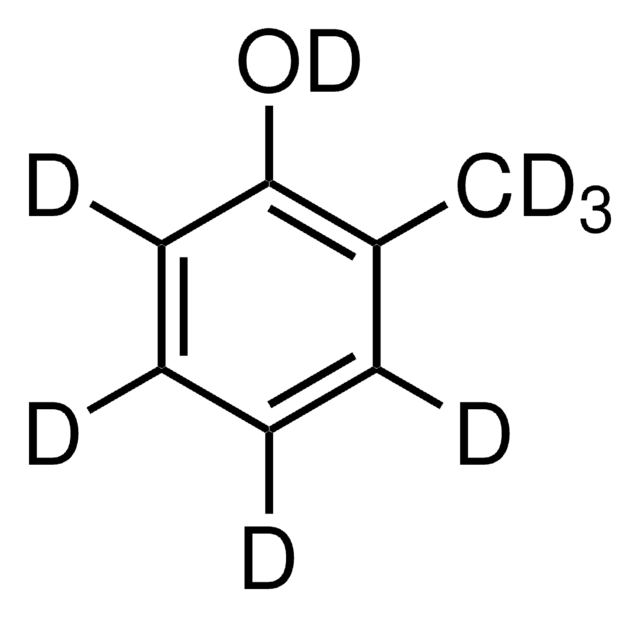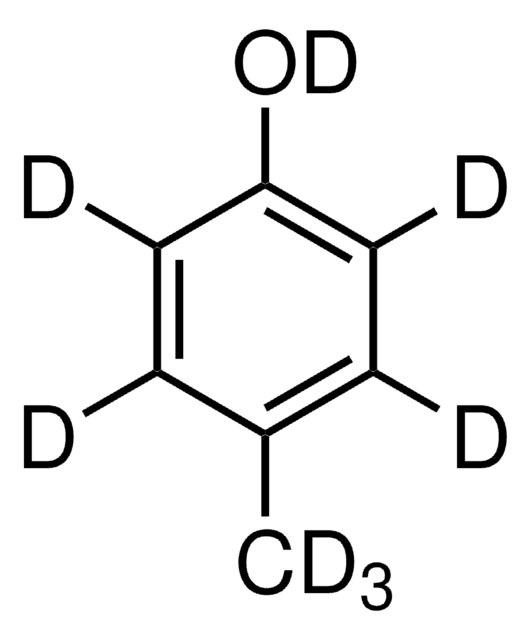42429
p-Cresol
analytical standard
Sinonimo/i:
4-Methylphenol
About This Item
Prodotti consigliati
Grado
analytical standard
Livello qualitativo
Densità del vapore
3.72 (vs air)
Tensione di vapore
1 mmHg ( 20 °C)
Saggio
≥99.0% (GC)
Temp. autoaccensione
1038 °F
Durata
limited shelf life, expiry date on the label
Limite di esplosione
1 %
1.1 %, 150 °F
tecniche
HPLC: suitable
gas chromatography (GC): suitable
P. ebollizione
202 °C (lit.)
Punto di fusione
32-34 °C (lit.)
32-35 °C
Densità
1.034 g/mL at 25 °C (lit.)
applicazioni
agriculture
cleaning products
cosmetics
environmental
flavors and fragrances
food and beverages
personal care
Formato
neat
Stringa SMILE
Cc1ccc(O)cc1
InChI
1S/C7H8O/c1-6-2-4-7(8)5-3-6/h2-5,8H,1H3
IWDCLRJOBJJRNH-UHFFFAOYSA-N
Cerchi prodotti simili? Visita Guida al confronto tra prodotti
Descrizione generale
Find all available reference materials for compounds listed in 10/2011 here
Applicazioni
Avvertenze
Danger
Indicazioni di pericolo
Classi di pericolo
Acute Tox. 3 Dermal - Acute Tox. 3 Oral - Aquatic Chronic 3 - Eye Dam. 1 - Skin Corr. 1B
Codice della classe di stoccaggio
6.1A - Combustible acute toxic Cat. 1 and 2 / very toxic hazardous materials
Classe di pericolosità dell'acqua (WGK)
WGK 2
Punto d’infiammabilità (°F)
186.8 °F - closed cup
Punto d’infiammabilità (°C)
86 °C - closed cup
Dispositivi di protezione individuale
Eyeshields, Faceshields, Gloves, type P3 (EN 143) respirator cartridges
Scegli una delle versioni più recenti:
Possiedi già questo prodotto?
I documenti relativi ai prodotti acquistati recentemente sono disponibili nell’Archivio dei documenti.
I clienti hanno visto anche
Articoli
Separation of 2-Chlorophenol; 2,4-Dichlorophenol; 2,4,6-Tribromophenol; 2,4,6-Trichlorophenol; 2,4-Dinitrophenol; Pentafluorophenol; 2-Methylphenol, analytical standard; 2,3,4,6-Tetrachlorophenol; Pentachlorophenol; 4-Nitrophenol; 2-Bromophenol; 2,3,5,6-Tetrachlorophenol; 2,3,5-Trichlorophenol; 4-Chloro-3-methylphenol; 2,4,5-Trichlorophenol; 4-Methylphenol, analytical standard; 2,4-Dimethylphenol; 2-Nitrophenol; 3-Methylphenol, analytical standard; Phenol; 2-Methyl-4,6-dinitrophenol; 2,3,4-Trichlorophenol; 2,6-Dichlorophenol; 2,3,4,5-Tetrachlorophenol
Protocolli
HPLC Analysis of Cresols and Phenol on Astec® CYCLOBOND® I 2000
GC Analysis of Xylene Isomers on SLB®-IL60
Il team dei nostri ricercatori vanta grande esperienza in tutte le aree della ricerca quali Life Science, scienza dei materiali, sintesi chimica, cromatografia, discipline analitiche, ecc..
Contatta l'Assistenza Tecnica.













